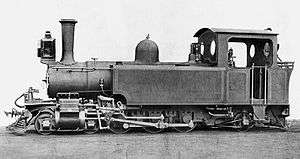CGR NG 4-6-2T
The Cape Government Railways NG 4-6-2T of 1908 was a South African narrow-gauge steam locomotive from the pre-Union era in the Cape of Good Hope.
| CGR NG 4-6-2T South African NG 4-6-2T | |||||||||||||||||||||||||||||||||||||||||||||||||||||||||||||||||||||||||||||
|---|---|---|---|---|---|---|---|---|---|---|---|---|---|---|---|---|---|---|---|---|---|---|---|---|---|---|---|---|---|---|---|---|---|---|---|---|---|---|---|---|---|---|---|---|---|---|---|---|---|---|---|---|---|---|---|---|---|---|---|---|---|---|---|---|---|---|---|---|---|---|---|---|---|---|---|---|---|
 CGR narrow-gauge 4-6-2T | |||||||||||||||||||||||||||||||||||||||||||||||||||||||||||||||||||||||||||||
| |||||||||||||||||||||||||||||||||||||||||||||||||||||||||||||||||||||||||||||
| |||||||||||||||||||||||||||||||||||||||||||||||||||||||||||||||||||||||||||||
| |||||||||||||||||||||||||||||||||||||||||||||||||||||||||||||||||||||||||||||
| |||||||||||||||||||||||||||||||||||||||||||||||||||||||||||||||||||||||||||||
| The 2nd coupled axle had flangeless wheels | |||||||||||||||||||||||||||||||||||||||||||||||||||||||||||||||||||||||||||||
In 1908, the Cape Government Railways placed two 4-6-2T Pacific type narrow-gauge steam locomotives in passenger service on the Walmer branch in Port Elizabeth. In 1912, both locomotives were assimilated into the South African Railways and renumbered.[1][2][3][4]
Manufacturer
Two 4-6-2 Pacific type narrow-gauge side-tank steam locomotives were built for the Cape Government Railways (CGR) by W.G. Bagnall in 1908. The engines were equally powerful tank locomotive versions of the CGR Type B 4-6-0 narrow-gauge tender locomotive of 1904, also built by Bagnall, but with Walschaerts instead of Stephenson valve gear. They were not classified and were numbered 42 and 43.[2][3][5][6]
Characteristics
Like their Type B 4-6-0 sister engines, the locomotives had bar frames. The drivers, the middle wheelset of the coupled wheels, were flangeless to enable the engine to negotiate sharp curves. The coupled wheels were not spaced equidistant from each other, with 39 inches (991 millimetres) between the wheel centres of the leading wheelset and the drivers and 36 inches (914 millimetres) between the wheel centres of the drivers and the trailing wheelset.[3]
Service
Cape Government Railways
In 1906, a passenger-only suburban branch line had been opened from Valley Junction, near Port Elizabeth on the Avontuur line, to the suburb of Walmer. It was used by up to 22 trains per day. Both locomotives were placed in service on the Walmer branch line.[2][3][7]
South African Railways
When the Union of South Africa was established on 31 May 1910, the three Colonial government railways (CGR, Natal Government Railways and Central South African Railways) were united under a single administration to control and administer the railways, ports and harbours of the Union. Although the South African Railways and Harbours came into existence in 1910, the actual classification and renumbering of all the rolling stock of the three constituent railways were only implemented with effect from 1 January 1912.[1][8]
In 1912, the two locomotives were renumbered no. NG33 and NG34 on the South African Railways (SAR), with the "NG" number prefix identifying them as narrow-gauge locomotives in the SAR registers. They remained in service on the Walmer branch for the duration of their service lives, until the line was closed in 1929. They were then withdrawn from service, shortly before a classification system for narrow-gauge locomotives was to be introduced by the SAR.[2][3]
References
| Wikimedia Commons has media related to CGR NG 4-6-2T. |
- Classification of S.A.R. Engines with Renumbering Lists, issued by the Chief Mechanical Engineer’s Office, Pretoria, January 1912, p. 47 (Reprinted in April 1987 by SATS Museum, R.3125-6/9/11-1000)
- Paxton, Leith; Bourne, David (1985). Locomotives of the South African Railways (1st ed.). Cape Town: Struik. pp. 113, 156. ISBN 0869772112.
- Espitalier, T.J.; Day, W.A.J. (1944). The Locomotive in South Africa - A Brief History of Railway Development. Chapter II - The Cape Government Railways (Continued). South African Railways and Harbours Magazine, April 1944. pp. 253-257.
- Dulez, Jean A. (2012). Railways of Southern Africa 150 Years (Commemorating One Hundred and Fifty Years of Railways on the Sub-Continent – Complete Motive Power Classifications and Famous Trains – 1860–2011) (1st ed.). Garden View, Johannesburg, South Africa: Vidrail Productions. p. 232. ISBN 9 780620 512282.
- Baker, Allan C.; Civil, T. D. Allen (1984). Bagnalls of Stafford – Locomotive Works List (1st ed.). England: The Industrial Locomotive Society
- Soul of A Railway - System 3: Cape Midland, based in Port Elizabeth – Part 1: The Port Elizabeth Narrow Gauge – Captions 8–10 (Accessed on 10 December 2016)
- Rollison, Richard (23 November 1973). "Saga of the Apple Express". Evening Post. Retrieved 26 December 2011..
- The South African Railways - Historical Survey. Editor George Hart, Publisher Bill Hart, Sponsored by Dorbyl Ltd., Published c. 1978, p. 25.